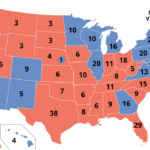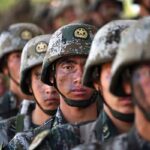- Cover Story
- Governance
- Globe Scan
- Corruption
- State Scan
- Talk Time
- Cover Story
- Governance
- Globe Scan
- Corruption
- State Scan
- Talk Time
Recent Posts
© Copyright 2007 - 2023 Gfiles India. All rights reserved powered by Creative Web INC.DiplomacyDiplomacy : Need for Power Projection beyond Doklam
China’s pull out from Doklam is a confirmation and acceptance of India’s assertive power in the region. But, India needs to speed up not only the modernisation of its military power but also integration of military in its geo-political and foreign policy discourse and implementation
Karan KharbSeptember 15, 20176 Mins read846 Views
 The Prime Minister, Shri Narendra Modi being welcomed by the President of the People’s Republic of China, Mr. Xi Jinping, at the 9th BRICS summit, in Xiamen, ChinaWritten by Karan Kharb
The Prime Minister, Shri Narendra Modi being welcomed by the President of the People’s Republic of China, Mr. Xi Jinping, at the 9th BRICS summit, in Xiamen, ChinaWritten by Karan KharbEVER since the Chinese invasion of 1962, India-China relations have been sulking-surging through a tortuous course of politico-diplomatic-military dichotomies. That invasion, veterans would recall, had shocked the then Panchsheel preaching Nehru who had not only persistently ignored military advice but even rubbished the very idea of maintaining a military in a peace loving India where the Gandhian concept of Non-violence was to be the tool of power, not the Army! Whereas the post-Independence political discourse in India centred around peace, non-violence, socialism and non-alignment, Mao Zedong’s doctrine was “Political power grows from the barrel of a gun!” Having learnt its early lessons in Korea, China embarked upon transforming the ‘People’s Volunteers’ – as the Chinese military troops fighting in Korea (1950-53) were then called – into a regular People’s Liberation Army (PLA).
In India on the other side, even as hordes of Indian soldiers had sacrificed their lives in the two world wars, the Indian subcontinent remained unscathed by the devastation and misery the wars left behind as no battles were fought on the Indian territory. Despite the Allies’ victory in Wolrd War II, the British economy was shattered, and the Empire started crumbling. Freedom thus dawned upon India rather benignly without shedding much blood for it. Mahatma Gandhi was eulogised as the phenomenon of non-violence and attainer of India’s freedom. The military was pushed to the backyards of state power until the Chinese invasion jolted India out of its slumber in October 1962. Matters like defence, border security and military that had all along fallen on deaf ears until then, suddenly became issues of vital importance and national urgency. The shift in the mental disposition of the political leadership towards the military did bring in the desired effect. India not only won the Indo-Pak war of 1965 but even dismembered Pakistan in December 1971 forcing nearly a third of its army submit at the world’s largest and the first ever public surrender ceremony in history.
The Indian Army has come a long way since 1962. Today, it is reckoned just next to China’s PLA in strength and has a built-in potential to deter any invader, despite its modernisation process having to meander through unnecessary bureaucratic red tapeA well equipped, organised and motivated soldiery signifies the level of coercive, persuasive and deterrent power of a nation in the modern world. Economy, trade and politico-diplomatic capacity of a country acquire meaning and credibility from its military potential. Two months of combative posturing of the PLA and the belligerent outbursts of the Chinese official media and spokespersons melted away after a series of diplomatic parleys between the two without a bullet being fired. Doklam that was aggressively claimed by China as its territory stays safe as an integral part of Bhutan and the PLA has called off its road construction activity in its vicinity as desired by India. Even as the international opinion favouring India’s stand on this issue built up, it would be an erroneous assumption that the Indian diplomatic moves were bereft of the military back up. It would have been unlikely that Chinese road construction planned into and through the Doklam plateau would have stopped if the Indian Army had not occupied these strategic heights to deter PLA’s ingress into the Bhutanese territory. Strategically, the narrow low lyingstrip of China’s Chumbi Valley is dominated by the Indian Army’s positions on heights in the west and the Doklam plateau in the south. China’s quest to close in and occupy Doklam heights is understandable, quite unfair though, to outflank Indian defences in Nathu La sector and threaten the Soliguri corridor.
Imagine if India were not a nuclear power and its military potential had remained weak. Would China just bark and rest for over 70 days? Would all the wisdom of India’s politicians and diplomats have deterred China from seizing these strategic heights – be it in Bhutan or India? Clearly unlikely. The Indian Army has come a long way since 1962. Today, it is reckoned just next to China’s PLA in strength and has a built in potential to deter any invader, despite its modernisation process having to meander through unnecessary bureaucratic red tape.
EVER since Prime Minister Narendra Modi’s arrival, however, there is a new thrust now underway to modernise and re-equip the Armed Forces at a priority. The Prime Minister has pledged $250 billion to replace and upgrade the inventory of armament like fighter aircraft, guns and submarines besides other warlike requirements of the Armed Forces. It is sad that in an age when India is viewed as an emerging great power with capacity to cast its influence globally, it also has the dubious distinction of being world’s largest importer of military hardware from the US, Russia, France and even smaller countries like Israel, Sweden, Italy and so on. Hopefully, the ‘Make in India’ initiative would reduce India’s dependence on other countries in the years to come. The ‘Make in India’ clause has been included in contracts recently signed with companies like Lockheed Martin Corp and Saab AB who have committed to manufacture in India. Many countries in the Indo-Pacific region, member-nations of SAARC and ASEAN, overawed by the raging ‘Charm Offensive’ of China, today look up to India for support and security – both economic and military. China’s pull out from Doklam is a confirmation and acceptance of India’s assertive power in the region. India has eloquently disapproved China’s hegemonic moves in the South China Sea (SCS). India’s stand has come as a reassurance for countries like Philippines, Vietnam, Taiwan, Malayasia and Brunei at a time when they look up to India for support against China’s brazen advances in the SCS through which 50 per cent of India’s trade passes.

Today, India commands confidence of more investors across the world than ever. Whereas China’s growth has slid to 6.3 per cent, India’s economy is still on steady upward growth path at 7.5 to 7.9 per cent, the post GST regime temporary dip notwithstanding. Another significant factor in favour of India is that whereas the number of non-performing older population will peak in China by 2030, more than 65 per cent of India’s population shall be below 35 years of age. To be of value, of course, this fast growing pool of younger work force will require better education, healthcare, and appropriate job opportunities.
In the face of such a future, China views India as a rival in its quest for becoming a world power. To contain it, therefore, China is trying to encircle India by developing deep sea water ports, airports, railroad network and setting up its naval bases in the Indian Ocean Region (IOR). Its ‘Maritime Silk Route’ diplomacy and the One-Belt-One-Road strategy starting with the China-Pakistan Economic Corridor from Kashgar in Xinjiang to Gwadar in Balochistannow clearly define China’s ‘String of Pearls’ to lay siege around India. What India’s leadership must understand is that China has integrated its military component in every commercial / economic project offered to the cash strapped littoral states in the IOR from Kenya to Myanmar. To make its voice heard and heeded with respect in the international power centres, India needs to speed up not only the modernisation of its military power but also integration of military in its geo-political and foreign policy discourse and implementation. It is sad that despite the high level Kargil Review Committee recommendations, the military has not yet been integrated even within the Ministry of Defence which is populated by militarily ignorant bureaucrats with little comprehension of strategic capabilities and requirements of the Armed Forces.
Economy, trade and politico-diplomatic capacity of a country acquire meaning and credibility from its military potential. Two months of combative posturing of the PLA and the belligerent outbursts of the Chinese official media and spokespersons melted away after a series of diplomatic parleys between the two without a bullet being firedNO country can become a global power merely on the strength of its economy. If it were so, Indonesia with its economy at $10.502 trillion would be a more dominant power than Russia at $7.131 trillion but it is not so. Thanks to its military power, Israel, on the other hand, is respected and feared in the region despite its tiny size and not so pompous economy. Strategists and policymakers of India must, therefore, weave the nation’s military potential in all its reckoning for overall development within and to protect and promote vital national interests beyond its own territory – regionally and globally. Maybe a good start could be made by ruthlessly curbing the babu versus military loathing going on for years, and the inter-Service rivalry within the three wings of the Armed Forces as well. The time is now ripe for India to prepare for power projection by establishing its dominance in South Asia, IOR and the Southeast Asian region in the coming years.
Recent Posts
- Governance
- Governance


























































